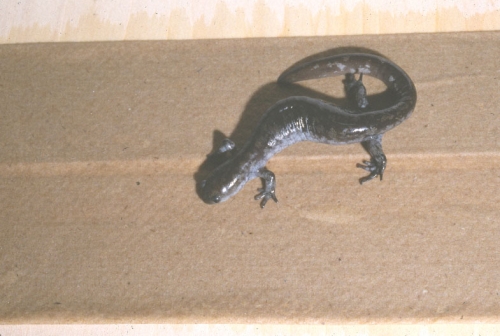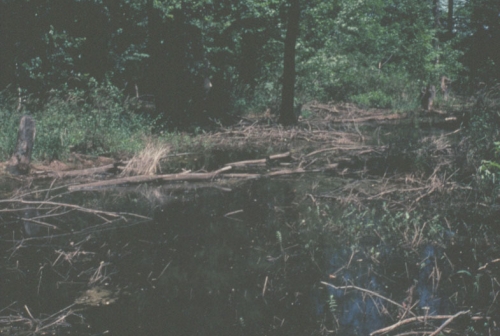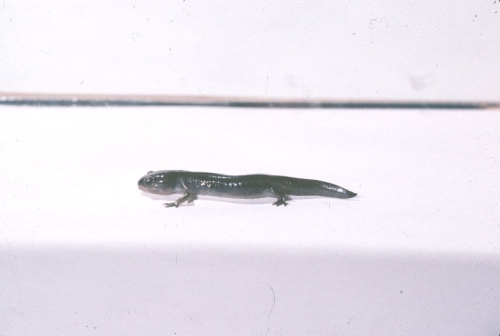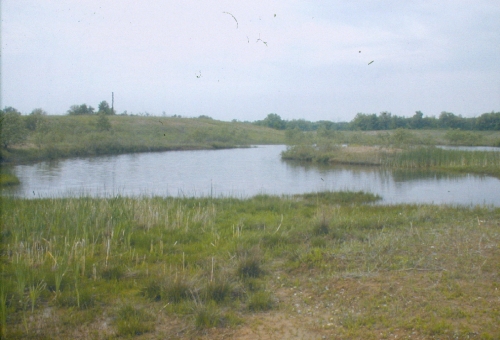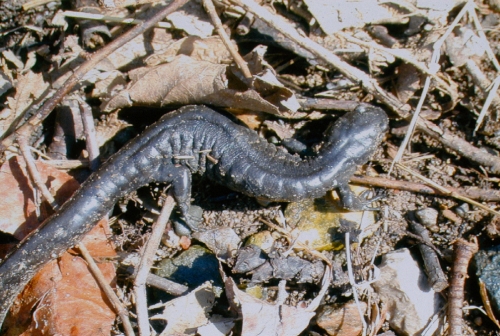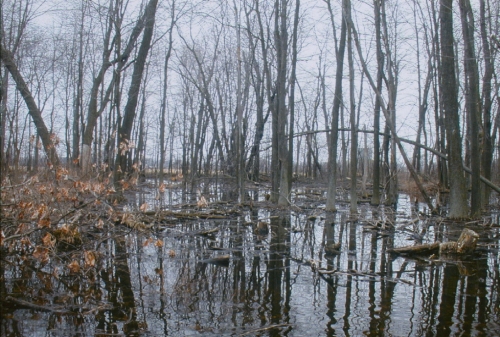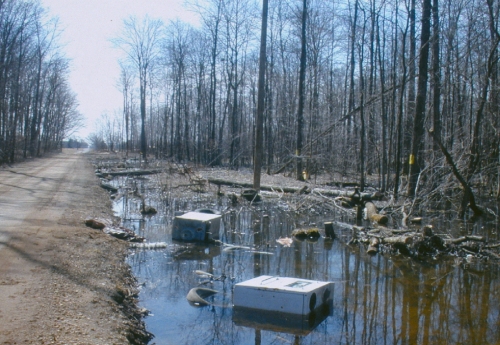Plants and Animals
Ambystoma texanum Small-mouthed salamander
Key Characteristics
The Smallmouth Salamander is a medium-sized salamander (4.3 - 7 inches adult length) with a small head and snout as its name implies. The head often looks swollen behind the eyes, and the lower jaw barely protrudes beyond the upper jaw when viewed in profile. The adults are brownish gray to grayish black with light gray speckles of lichen like markings, particularly along the lower sides of the body. The hybrids may be intermediate in form and color or may resemble one or the other of the parent species.
Status and Rank
US Status: No Status/Not Listed
State Status: E - Endangered (legally protected)
Global Rank: G5 - Secure
State Rank: S1 - Critically imperiled
Occurrences
| County | Number of Occurrences | Year Last Observed |
|---|---|---|
| Hillsdale | 7 | 2024 |
| Monroe | 4 | 2001 |
| Oakland | 1 | 1963 |
| Washtenaw | 2 | 2001 |
| Wayne | 1 | 2001 |
Information is summarized from MNFI's database of rare species and community occurrences. Data may not reflect true distribution since much of the state has not been thoroughly surveyed.
Habitat
Smallmouth Salamanders inhabit forested bottomlands and associated wetlands in or adjoining floodplains. They also can utilize more open habitats such as prairies and farm fields. Smallmouth Salamanders require temporary, shallow bodies of water, which are usually fish-free, for breeding. Outside the spring breeding season, Smallmouth Salamanders generally remain hidden beneath rotting logs, rocks or leaf litter or underground in crayfish or small mammal burrows. Juveniles and adults appear to generally remain close to their breeding ponds.
Specific Habitat Needs
Downed woody debris needed in: Floodplain forest; Inundated shrub swamp; Mesic southern forest; Southern hardwood swamp; Southern wet meadow; Wet prairie.
Natural Community Types
- Floodplain forest
- Inundated shrub swamp
- Mesic southern forest
- Southern hardwood swamp
- Southern wet meadow
- Wet prairie
For each species, lists of natural communities were derived from review of the nearly 6,500 element occurrences in the MNFI database, in addition to herbarium label data for some taxa. In most cases, at least one specimen record exists for each listed natural community. For certain taxa, especially poorly collected or extirpated species of prairie and savanna habitats, natural community lists were derived from inferences from collection sites and habitat preferences in immediately adjacent states (particularly Indiana and Illinois). Natural communities are not listed for those species documented only from altered or ruderal habitats in Michigan, especially for taxa that occur in a variety of habitats outside of the state.
Natural communities are not listed in order of frequency of occurrence, but are rather derived from the full set of natural communities, organized by Ecological Group. In many cases, the general habitat descriptions should provide greater clarity and direction to the surveyor. In future versions of the Rare Species Explorer, we hope to incorporate natural community fidelity ranks for each taxon.
Management Recommendations
Protecting known Smallmouth Salamander sites and maintaining suitable habitat at these sites are essential for conservation of this species. Maintaining and/or constructing a complex of natural or artificial vernal ponds within suitable forested habitats would provide breeding, foraging and dispersal habitat for this species. Vernal ponds that are fish-free and hold water through at least July would be most beneficial to this species. Maintaining cool, moist microenvironments and sufficient leaf litter and woody debris on the forest floor is important for providing cover and foraging habitat for juveniles and adults. Managing forested habitats utilizing partial harvest techniques and longer rotation cycles would likely benefit this species. Exposure to highly acidic conditions and/or chemical pollutants should be minimized to reduce the potential for adverse impacts to Smallmouth Salamanders until more is known about their potential impacts.
Active Period
Breeding from third week of February to fourth week of March
Survey Methods
The best time to survey for this species is during the spring breeding season when adult Smallmouth Salamanders are migrating to and congregating in breeding ponds. Migrations to breeding sites typically occur at night during rainy weather. Surveys can be conducted using aquatic minnow traps to capture adults in the breeding ponds or using drift fences with or without pitfall traps placed around breeding ponds to intercept individuals entering or exiting the ponds. Surveys for aquatic larvae or newly transformed juveniles dispersing from breeding ponds also can be conducted in the spring and/or summer (i.e., April – June/July) using minnow traps or drift fences with or without pitfall traps, respectively. Trapping should occur on multiple nights during the breeding season, and drift fences and traps should be checked on a daily/nightly basis.
Trapping with drift fence with or without pitfall traps
Survey Period: From third week of February to fourth week of March
Time of Day: Night
Humidity: Humid
Precipitation: Rainy
Wind: Light Breeze
Trapping with minnow traps
Survey Period: From third week of February to fourth week of March
Time of Day: Night
Humidity: Humid
Precipitation: Rainy
Wind: Light Breeze
References
Survey References
- Heyer, W.R., M.A. Donnelly, R.W. McDiarmid, L.C. Hayek, and M.S. Foster, eds. 1994. Measuring and Monitoring Biological Diversity: Standard Methods for Amphibians. Smithsonian Institution Press, Washington D.C. 364pp.
- Karns, D.R. 1986. Field Herpetology: Methods for the Study of Amphibians and Reptiles in Minnesota. Occ. Pap. No. 18. J.F. Bell Museum of Natural History, University of Minnesota, Minneapolis.
Technical References
- deMaynadier, P.G. and M.L. Hunter, Jr. 1995. The relationship between forest management and amphibian ecology: A review of the North American literature. Environmental Review 3:230-261
- Harding, J.H. 1997.Amphibians and Reptiles of the Great Lakes Region. The University of Michigan Press, Ann Arbor. 378pp.
- Minton, S.A. 1972. Amphibians and Reptiles of Indiana. Indiana Academy of Science, Indianapolis. 3: 346pp.
- Petranka, J.W. 1998. Salamanders of the United States and Canada. Smithsonian Institution Press, Washington, D.C. 587pp.
- Pfingsten, R.A. and F.L. Downs. 1989. Salamanders of Ohio. Bulletin of the Ohio Biological Survey 7(2):1-315.
- Smith, P.W. 1961. The amphibians and reptiles of Illinois. Illinois Natural History Survey, Carbondale. Bulletin No. 28. 298 pp.
- Wyman, R.L. 1988. Soil acidity and moisture and the distribution of amphibians in five forests of south-central New York. Copeia 1988:394-399.
- Wyman, R.L. and J. Jancola. 1992. Degree and scale of terrestrial acidification and amphibian community structure. Journal of Herpetology 26:392-401.


